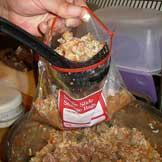
I recently came across a research article that may help explain why cats are such finicky eaters. The scientists concluded that cats are genetically different from most mammals in that they lack the genes necessary for tasting sweet substances. They explain it this way:
Sweet compounds, including sugars and artificial sweeteners, are recognized by a special taste bud receptor composed of the products of two genes. The authors found that in cats, one of these genes is not functional and is not expressed. (It is called a pseudogene.) Because the sweet receptor cannot be formed, the cat cannot taste sweet stimuli.
The authors feel that this genetic difference may explain why cats in the wild eat few carbohydrates, instead preferring to dine on protein. Our domesticated felines are strict carnivores as well, and fare better on high protein rather than high carbohydrate diets.
What other factors are important to cats in when they select their food? A cat’s food preferences are formed when he is young. What his mother ate during gestation and nursing plus the types of foods the kitten was exposed to early in life play a big role in his preferences. Therefore, when kittens are young, it is important to offer a variety of foods (only small amounts at a time over the course of many days to avoid causing digestive tract upset). Some cats may develop a medical condition later in life that could be better managed with a canned diet (e.g., kidney disease), so it is important that they will accept this type of food.
Cats tend to eat better when they are relaxed. Since they are usually solitary hunters in the wild, they can take their time when eating their food. You may have noticed that your cat eats better when you are home or better yet, while you are petting him. It’s important to keep feeding time as stress-free as possible. In comparison, wild dogs often hunt in packs and have to compete for their food, so they have a tendency to gulp their food down.
There are many food-related factors that are important to cats. Aroma is vital, so canned food is often preferred as it gives off its smells more readily than dry. Temperature also plays a big role since cold foods do not give off as much aroma. If the canned food is stored in the fridge, it is a good idea to warm it to body temperature (approximately 100 degrees Fahrenheit) before feeding, taking care to mix it thoroughly to avoid burns. Texture is also important to cats. They prefer solid and moist foods (think mice). Even shape can be factor. I read an interesting study by Kristopher Figge in which 25 cats were fed different-shaped kibble over two days. The preferred shape of kibble was the “O” (disc), just barely beating out the “X” (cross/star) shape.
Feline anatomy also affects feeding behaviors. Cats are unable to grind their food because their teeth are all pointy with no flat occlusal (chewing) surfaces. Cats also cannot move their jaws horizontally, limiting their ability to chew their food. Domesticated cats mostly swallow dry food whole, unless it is a larger dental diet where some chewing is necessary.
Owners are able to affect only some of these parameters. Through trial and error we can usually find a food that a particular cat will like, but we can’t expect him to completely abandon his finicky ways.

Dr. Jennifer Coates
Reference
Scherk, Margie. Feline Nutrition: Special Features of Special Creatures. Accessed from Veterinary Information Network (VIN) Rounds Discussion on January 28, 2014.
Image: Berents / Shutterstock










